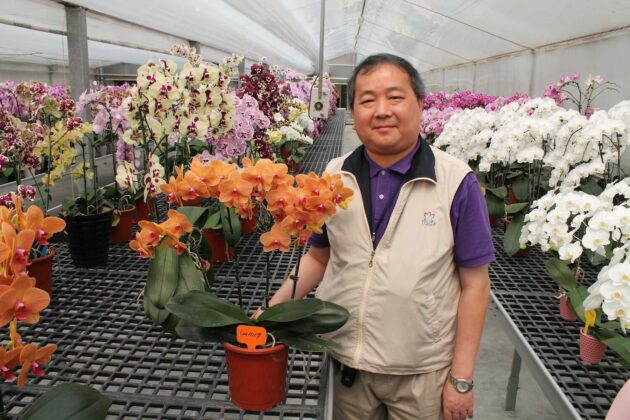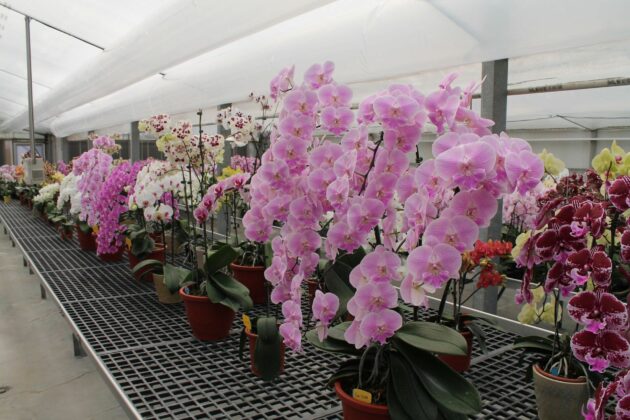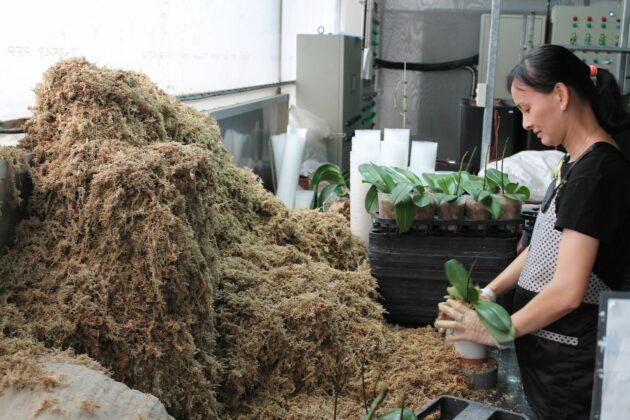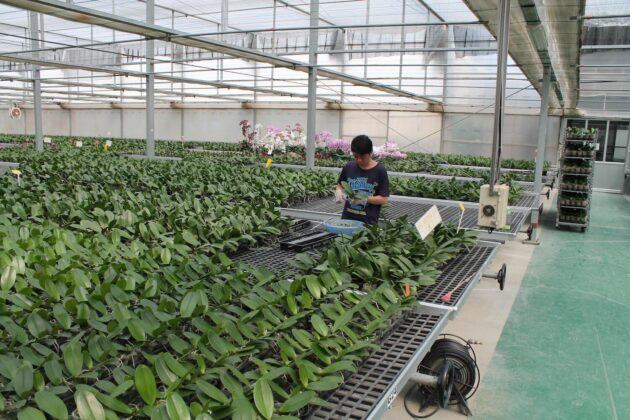At the Taiwan International Orchid Show (TIOS) in March this year, Tsang-Yu Lee’s snow-white phalaenopis was awarded best in show. The modest breeder has been active in the field for many years. He saw the rise of the Taiwanese orchid cultivation and export and he was involved in those developments as a committee member. He’s more than happy to give a tour of his company.
Tsang-Yu Lee proudly shows how he can regulate the climate in his greenhouse in California via his smartphone. On the switch box at his company in Taiwan, we see how he quickly changes a few settings. Lee has 8 acres, or a good 3 hectares, in North America. “That’s for the finishing stage of our phalaenopsis. We’ve been sending over young plants by boat from Taiwan since 1995.”
We don’t really get to find out about the total acreage of Lee’s greenhouses in Taiwan. He prefers to talk about breeding today; initially in his office and later on in the greenhouse where a number of his novelties are exhibited.
Concentration of companies
We’re at the so-called Taiwan Orchid Plantation (TOP), an area that the Taiwanese government assigned to orchid growers/breeders in 2004. It consists of a total of 157 ha, cultivated by 84 companies. This makes it the largest concentration of orchid companies worldwide. The greenhouses are mostly used to cultivate phalaenopsis.
Three of the plants on the exhibition tables of Char Ming Agriculture, the company of Tsang-Yu Lee, have been put to one side. “That plant over there was picked by Opti-flor, and the other two in the corner are for Anthura”, explains Lee. Growers from various countries choose cultivars with potential, preferably from crossing products that are still unnamed. That way, you’re ahead of everyone else, allowing you to claim exclusivity. Small trials subsequently have to determine whether your choice is a good addition to your assortment, maybe even through a new concept. If so, propagation in labs is the next step.
Breeders like Anthura use the Taiwanese novelties for their own breeding programmes. New, unique genes are highly desirable. Flowers with a large lip, for example, are still hard to find in the Netherlands.
Breeding programme
Lee has been growing phalaenopsis in Taiwan since 1989, and he has his own breeding programme. Colleagues from all over the world receive a warm welcome in his greenhouse with flowering novelties. They come throughout the year, with a peak in spring. Once they’ve made their choice, a trial shipment of around 300 young plants is sent to the relevant grower. “We pot a few plants ourselves at the same time, so that we can compare the growth and development of the specific cultivar. We also travel abroad on a regular basis, to see how our assortment’s doing at the customer’s company.”
Snow-white flowers
Phalaenopsis comes in an enormous variety of shapes and colours. The tables filled with flowering plants make for a dazzling display. Lee points at a cultivar with snow-white flowers. Dozens of flowers. A blue card says ‘Lee 1288’. “This is a sister of the cultivar that was chosen as most beautiful orchid recently, at the international TIOS show, from 1,327 entries. That was Charming Prince ’Lee 1285’. It had 142 flowers on three branches.”
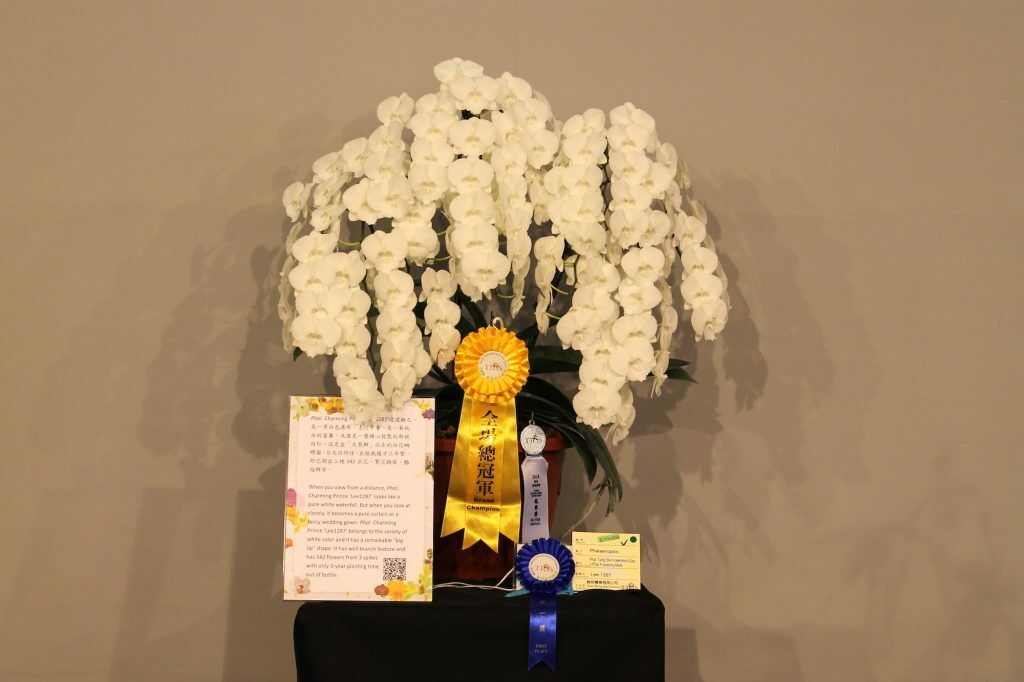
TIOS (Taiwan International Orchid Show) is a 10-day event, which has been held each year since 2005 at the Taiwan Orchid Plantation. Lee is a loyal exhibitor. He knows how to impress the jury. The award-winning plant flowered for the first time in 2016. The fact that this was its third bloom explains the large quantity of snow-white flowers. And they managed to position them in such a way that it seemed like one large curtain of flowers. Something they didn’t manage with sister plant ‘Lee 1288’, so she had to stay at home.
Charming Fortune
We’re making our way over to another one of Lee’s favourites. It’s Charming Fortune, characterised by its orange flowers. The card in the pot shows a number that connoisseurs would recognise: ‘Lee 1019’. “I had this one registered for plant breeders’ rights in 2011. More than 500,000 young plants of this cultivar are shipped to customers in Europe and North and South America each year. It isn’t grown in Taiwan. They don’t like this colour. But there’s slowly emerging a demand for Charming Fortune in Korea, and growers in Vietnam are also starting to show an interest.”
Lee says that applying for plant breeders’ rights is most straightforward in Taiwan, Japan and the Netherlands. In the United States on the other hand, applications can take up to 1.5 years to complete. The costs vary per country, but what matters most to the breeder, is the way in which his cultivars are treated. “The Dutch don’t copy, but Chinese and Vietnamese do.”
Certified greenhouses
From the show greenhouse, we walk over to the departments where young plants are grown. Workers are busy removing excess roots with a small pair of scissors. There isn’t much colour in the greenhouse. It’s mainly young plants here. Most of them will be shipped to Lee’s nursery in North America, where they will bloom. There are signs on the greenhouse doors indicating that the company has the USDA certification required for those exports.
Is pot worm a problem for Lee? He smiles and points at the sphagnum in the pots and the mesh cloth visible through the vents. The growing medium has been steam treated and it’s almost impossible for harmful insects to fly in, because the greenhouse is completely covered by the black mesh cloth. The cloth stops irradiation too. Humidification, shade cloth in the greenhouse and a pad-and-fan system all help with cooling too. Lee even installed air conditioners with hoses running underneath the tables. Anything for optimum growth. Abroad and on his 4,5 ha with phalaenopsis in Taiwan, Lee added.

